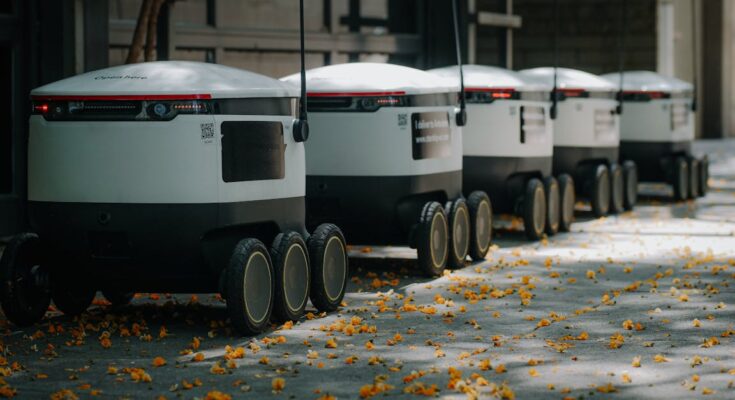Hey there! Ever see those movies or news stories about cars that drive themselves and think, "Whoa, is that actually happening?" Or maybe you’ve been stuck in traffic and wished your car could just take over so you could scroll through your phone or finish that podcast? You’re not alone! Lots of folks are wondering what the deal is with self-driving cars and what they mean for our future. Are we talking about robot chauffeurs for everyone, or just souped-up cruise control? We get it, it feels a bit sci-fi, but it’s also becoming super real. This article is gonna break down what the future of autonomous vehicles looks like, explain how they work (kinda!), what challenges they face, and what life might be like when they’re more common. Stick around, and you’ll get a much clearer picture of this wild ride ahead.
What Exactly *Are* Self-Driving Cars? (It’s Not All or Nothing)
Okay, first things first. When people talk about “self-driving cars,” they’re not always talking about the same thing. It’s not just an on/off switch. Think of it more like levels, kind of like video game levels from 0 to 5. Most cars you see on the road today aren’t really self-driving at all – that’s Level 0. Maybe your car has cruise control, where it keeps a steady speed on the highway? That’s like Level 1. It helps you out a tiny bit with one task.
Then there’s Level 2, which is what a lot of newer, fancy cars have. This is stuff like adaptive cruise control that slows you down if the car in front does, or lane keeping assist that nudges you back if you start drifting. It’s like the car is helping with two things at once, but *you* still have to pay attention and be ready to take over any second. It’s still *your* responsibility to drive.
Levels 3, 4, and 5 are where things get really interesting, and these are the ones we usually mean when we talk about “the future.” At Level 3, the car can handle most of the driving in certain situations (like on a specific highway), but you still need to be ready to take back control if the car asks you to. It’s a bit tricky because you have to stay alert even when you’re not actively driving.
Level 4 is where the car can drive itself completely within a specific area or under certain conditions, without you needing to take over *at all* in those situations. Think robotaxis operating in a specific city neighborhood. If it leaves that area or the weather gets too bad, it might need human help, or it might just stop safely.
And Level 5? That’s the holy grail – a car that can drive itself anywhere, anytime, in any conditions a human driver could handle. No steering wheel, no pedals needed. You just tell it where to go, and off it goes. This is the true “set it and forget it” self-driving dream, and it’s still a ways off for everyday cars.
How Do These Things Even See the Road? (Sensors, Maps, and Brains)
So, how do these cars know what’s going on around them without eyes and ears like ours? They use a bunch of high-tech gadgets that act like super-powered senses. Think of it like giving the car a whole bunch of ways to understand the world.
They have cameras, which are like the car’s eyes. They see lane lines, traffic signs, traffic lights, and other cars. Some cars have cameras all around to get a full 360-degree view.
Then there’s radar. This technology uses radio waves to detect objects and figure out how fast they’re moving and how far away they are, even in fog or darkness. It’s like a superpower for seeing through bad weather.
Lidar is another cool one. It uses lasers to create a detailed 3D map of the car’s surroundings. Imagine shooting out millions of tiny light pulses and timing how long they take to bounce back. This builds a super-accurate picture of everything nearby – other cars, pedestrians, buildings, even how bumpy the road is. It’s like giving the car a sense of touch over distances.
On top of the sensors, they need GPS to know where they are on a map, and sometimes really detailed, pre-made maps that show road layout, landmarks, and even things like curb heights.
All this information – from cameras, radar, lidar, GPS, etc. – goes into the car’s computer brain. This is where the magic really happens. Powerful software, often using artificial intelligence (AI), takes all that data and processes it instantly. It has to figure out: “Okay, based on everything I see and know, where am I? What’s around me? Is that a pedestrian or a lamppost? Is that car slowing down? What should I do next? Should I speed up, slow down, turn?” It’s making thousands of tiny decisions every second, just like your brain does when you’re driving.
Why Isn’t Every Car Self-Driving Already? (The Big Roadblocks)
If the technology sounds so cool, why aren’t we all just kicking back in the passenger seat on our way to school or work? Well, making a car truly drive itself safely and reliably in the real world is incredibly hard. Like, really, really hard. There are some big obstacles in the way.
One of the biggest challenges is dealing with unpredictable stuff. Real-world driving isn’t like a perfect video game. What about crazy weather like a sudden blizzard or torrential rain that blinds the sensors? What about road construction that wasn’t on the map? What about a pedestrian suddenly running into the street? Humans do unexpected things, and the car’s AI has to be prepared for pretty much anything.
Then there are the ethical dilemmas. This sounds heavy, but think about it: What if a self-driving car is in a situation where an accident is unavoidable? Does it prioritize protecting the people inside the car, or minimizing harm to pedestrians, even if it means crashing itself? These are incredibly tough decisions that humans struggle with, and programming a car to make them is a huge debate.
Safety and security are massive. People need to trust that these cars won’t malfunction or, even scarier, get hacked. Imagine if someone could remotely control or mess with a self-driving car. Yikes. Making the software and systems super secure is critical.
Also, the technology is still expensive and complex. Those lidar sensors? They aren’t cheap. Writing and testing the software to handle every possible driving scenario takes ages and costs billions. Plus, rules and regulations haven’t fully caught up with the technology yet. Governments need to figure out who is responsible if there’s an accident involving a self-driving car.
What Could Change in Our Daily Lives? (Think Beyond Just Driving)
Okay, let’s imagine that future where self-driving cars are common. How might that actually change stuff for you and me? It’s way more than just not having to hold the steering wheel.
For one, commuting could be totally different. Stuck in traffic for an hour every morning? Instead of gripping the wheel and getting stressed, maybe you could read a book, watch a show, work on your laptop, or just relax. Your commute time could become free time! Imagine a teenager finishing their homework on the way to band practice, or a parent getting a head start on emails before getting to the office.
Cities might change. Do we need as much parking space if cars can drop you off and then go park themselves miles away, or maybe even pick up other people? Could streets be designed differently if we expect traffic to flow more smoothly and predictably? Maybe fewer accidents means less need for traffic cops directing things manually.
Think about deliveries and transportation for goods. Self-driving trucks and delivery vans could potentially run almost non-stop, changing how quickly we get packages or how stores get their supplies.
And what about people who can’t drive today, like the elderly or those with disabilities? Self-driving cars could give them a whole new level of freedom and independence to get around without needing someone else to drive them.
Even the idea of owning a car could change. Maybe instead of everyone owning a car that sits in a driveway most of the time, more people will use robotaxi services – you just summon a car with an app, it picks you up, and takes you where you need to go. Like a super-efficient, always-available taxi.
Safety First, Right? (The Promises vs. The Worries)
One of the biggest reasons companies are pushing for self-driving cars is the potential for improved safety. Most car accidents today are caused by human error – things like distracted driving (looking at your phone!), driving while tired, speeding, or driving after drinking alcohol. Computers don’t get distracted, tired, or drunk.
The idea is that a self-driving car, constantly scanning its surroundings with multiple sensors and reacting much faster than a human, could avoid many crashes that happen today. Imagine roads with far fewer serious accidents – that would be a huge win.
But, of course, there are new worries too. What happens if a sensor fails in critical moment? What if there’s a glitch in the software? We already talked about the risk of hacking. While self-driving cars are designed with backup systems and extensive testing, people are naturally cautious about handing over control to a machine.
There have been accidents involving self-driving test vehicles, which highlight that this technology isn’t perfect yet and needs rigorous testing and validation before it’s widespread. Building public trust is a key part of this future. People need to feel genuinely safe sharing the road with (and riding in) these cars.
Who’s Going to Be Driving These Things Anyway? (Jobs and the Economy)
When you think about cars driving themselves, a question pops up: what about all the people whose jobs involve driving? This is a really important point to consider.
Think about truck drivers who move goods across the country, taxi and rideshare drivers in cities, or delivery drivers bringing packages to your door. As self-driving technology improves, especially for things like long-haul trucking on highways or fixed-route delivery, some of these jobs could definitely change or decrease over time.
This isn’t a small thing, and it’s something governments and communities will need to think about and plan for. It’s not just about replacing drivers; it’s about supporting people who might need to find new kinds of work.
However, it’s not just about job losses. This new technology also creates new kinds of jobs. We’ll need people to design, build, and maintain the self-driving systems and the cars themselves. We’ll need folks to manage the fleets of robotaxis and delivery vehicles, handle logistics, and maybe even remote operators who can take over if an autonomous vehicle gets stuck in a really tricky spot.
So, while the types of jobs related to transportation might shift pretty dramatically, it’s also an opportunity for new industries and roles to emerge. It’s a complex economic puzzle to figure out.
When Will This Future *Actually* Get Here? (It’s Closer Than You Think, But…)
Alright, the million-dollar question: when do we get to ditch our car keys for good? The truth is, parts of the self-driving future are already here, and other parts are still decades away for most people.
Remember those levels we talked about? Level 2 features are available in lots of cars right now – that’s the adaptive cruise control and lane keeping stuff. More advanced Level 2+ or even limited Level 3 systems are starting to appear in some high-end vehicles, allowing for hands-free driving in very specific conditions.
Level 4 autonomous vehicles are operating today in certain cities, primarily as robotaxi services. You can download an app in places like Phoenix, San Francisco, or Guangzhou, China, and get a ride in a car with no human driver behind the wheel (though sometimes there’s a safety operator present). These services are usually limited to specific geographic areas and might not run in bad weather, but they are real.
So, the future is arriving piece by piece, in controlled environments first. Widespread adoption of Level 4 cars for personal ownership will likely take longer, maybe into the late 2020s or 2030s, starting in easier-to-map and less complex areas.
As for Level 5 – the car that can drive absolutely anywhere, anytime, just like a human? Most experts agree that’s still pretty far off, maybe 20 years or even more, before it becomes commonplace for regular folks to own one. There are still too many edge cases and unpredictable situations for the technology to handle perfectly everywhere.
So, don’t expect your family car to magically drive you on a cross-country road trip next year while you sleep in the back. But do expect to see more and more driver assistance features, and watch for those yellow diamond-shaped signs in some cities indicating areas where robotaxis operate. The change is happening gradually.
So, where does all this leave us? The world of self-driving cars is fascinating and changing really fast. We’ve seen that it’s not just one thing; there are different levels of autonomy, and the most advanced ones are still pretty new. These vehicles use complex technology like cameras, radar, and lidar to see, and powerful computers to make decisions, kind of like giving cars super senses and a super brain. But getting them to work perfectly everywhere is tough because of things like crazy weather, unpredictable people, and big questions about safety and ethics. Still, the possibilities are huge – imagine getting your commute time back, or cities changing how they’re designed. While there are real worries about jobs and safety, there’s also the potential for fewer accidents caused by human mistakes and new types of work. It’s not a flip-a-switch future; it’s coming step-by-step. We’re already seeing some self-driving cars in action today in certain places, but the truly go-anywhere car for everyone is still some time off. Keep an eye on the road (or maybe don’t, if you’re in a robotaxi!) because the future of getting around is definitely heading in a new direction.




